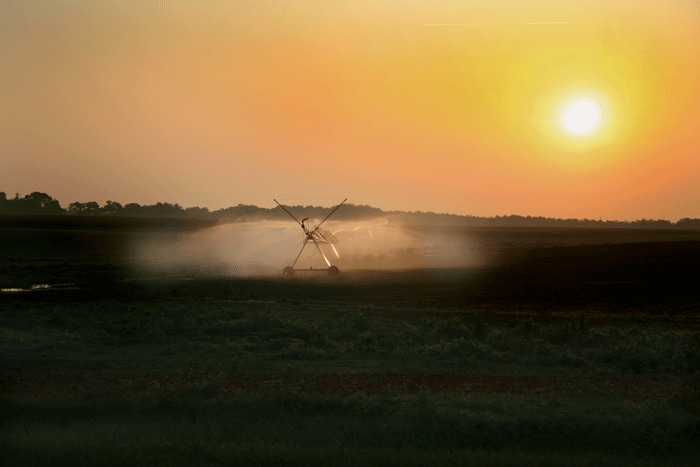October 17, 2011

Alabama row-crop farmers have historically been considered “under-irrigated,” especially when compared to their counterparts in neighboring states like Georgia, Florida and Mississippi.
And while the state, on average, receives abundant rainfall each year, precipitation is often inconsistent during the summer months, when plants need it the most.
Although data suggest that a major expansion of irrigation on Alabama’s farmland would significantly boost profit margins and agriculture’s impact on the state, growers said in a recent survey that too many obstacles still stand between them and adopting irrigation technology.
Currently it’s estimated that only about 10 percent of the state’s farmland is irrigated.
The survey — conducted by the Alabama Agricultural Experiment Station — randomly asked small, medium and large-scale irrigating and non-irrigating farmers what they considered to be their largest obstacles to adopting or expanding current irrigation capabilities.
Not surprisingly, the primary barrier was financial, including the costs of installing, improving and powering irrigation systems, the inability to finance such systems, and concerns that irrigation wouldn’t pay for itself.
The survey was conducted to give policymakers, farmers and others a greater understanding of how irrigation adoption affects the prosperity of Alabama farms, says Joseph Molnar, Auburn University rural sociologist and lead author for the study.
Annual rainfall in Alabama averages more than 48 inches, according to Molnar, but even in areas with abundant rainfall, drought stress can begin shortly after a rain or irrigation in soils such as those found in the Piedmont region of the state.
“Alabama agriculture has new possibilities for growth and stabilization through the implementation of irrigation,” says Molnar. But the survey suggests that farmers view water constraints and economics of irrigation as central barriers to implementing or expanding its use.
An interesting finding of the survey is that all operators reported facing “information limitations” that impeded the use of irrigation in their farming systems.
“The diversity of Alabama terrain, fields shapes and hydrology frequently requires technical assessment that may be difficult to provide in an era when the number of qualified providers may be declining,” says Molnar.
Public agencies can assist in siting wells and water storage ponds, but matching irrigation systems to specific farm situations often takes more comprehensive planning and is difficult to complete in a single year, he says.
“Thus, farmers often take a partial and incremental approach based on the water they have, or can get, and the investment they are willing to make,” according to the study.
Installation costs were the most frequently cited obstacle to implementing or improving irrigation, 64 percent overall.
More familiar with actual costs
More of those who already have irrigation cited this reason, perhaps because they are more directly familiar with actual costs, says Molnar. This was true for each size category, but operators of large farms cited this barrier the most, at 78 percent.
High energy costs were mentioned by 62 percent of the respondents, with small operators being less sensitive to this barrier.
“Financing the improvements was a barrier for 57 percent of the sample, although fewer small operators cited this barrier,” states the study.
“About half of the sample indicated the returns from irrigation would not cover installation costs — operators of large farms were more likely to feel this way.
“They also tended to feel that irrigation system operating costs were too risky. About half of the sample indicated this as “some” or a “great” barrier.
Lack of a reliable source of water was a barrier for 44 percent of all respondents, with more medium-size and large operations considering this as a barrier.
About 38 percent of the respondents said that getting good advice on how to make irrigation pay was a problem.
Overall, 41 percent of all respondents irrigated some or most of their row crops. Row crops such as corn, cotton, and soybeans were irrigated to some extent by 26 percent and were irrigated the most by 15 percent.
Operators of medium-size and large farms each irrigated row crops 52 percent. Only 20 percent of small farm operators, however, irrigated row crops to any extent.
The survey also found that technology was not widely used to make decisions on water applications by Alabama operators, despite the accessibility and ease-of-use of irrigation scheduling programs such as IrrigatorPro.
The majority of respondents — 81 percent — decided whether to apply water to their crops by observing crop conditions. An overwhelming 93 percent of large farm operators used crop observation, along with 86 percent of medium-size farm operators and 63 percent of small farm operators.
Forty-three percent of all respondents used the feel of the soil as the basis for deciding when to apply water to their crops. Only 9 percent used soil moisture-sensing devices, and only 4 percent based their decision to irrigate based on media reports on crop-water needs.
Another 4 percent decided when to apply water by computer simulation modes, and only 2 percent used a commercial scheduling service.
About the Author(s)
You May Also Like




